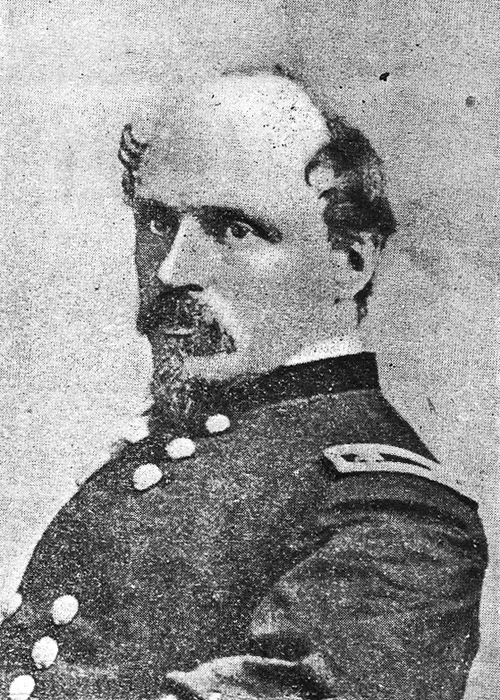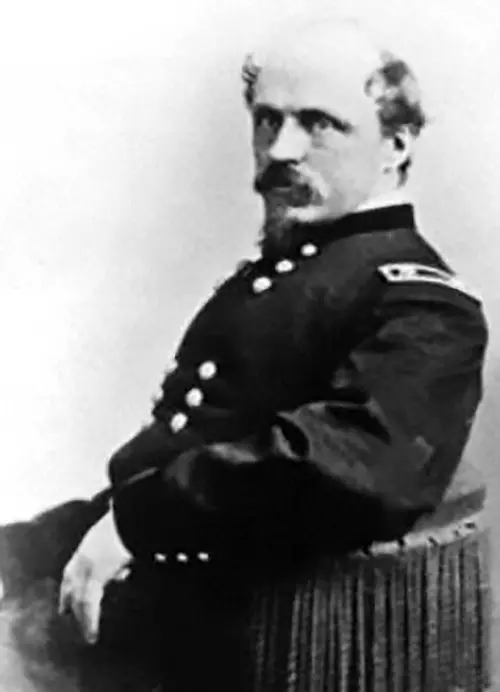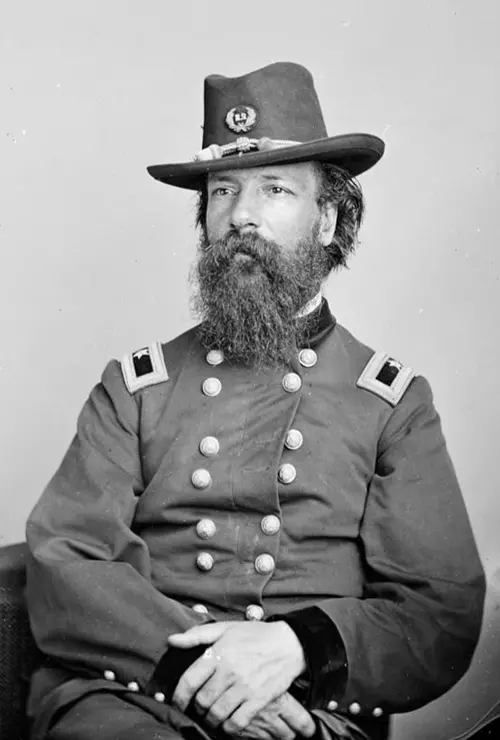 General John Wallace Fuller. Middle Bass Club member 1877 to 1890 with Mrs. Fuller being a member until 1898. Source: ironbrigader.com
General John Wallace Fuller. Middle Bass Club member 1877 to 1890 with Mrs. Fuller being a member until 1898. Source: ironbrigader.com
General John Wallace Fuller
John Wallace Fuller was born in Cambridge, England in 1826 and moved with his family to Utica, New York where he established a successful book selling and publishing business. After a fire ruined his business in 1859, Mr. Fuller moved to Toledo to start over. Although his publishing business was flourishing when the Civil War began, Mr. Fuller decided to join the Union cause.
The highlights of General Fuller’s military career include:
- Elected Colonel of the 27th Ohio Volunteer Infantry (OVI) in February 1862 and joined General John Pope with successful battles in New Madrid and Island No. 10 along the Mississippi river. (Source: Memoirs of Lucas Country & City of Toledo, Vol. II, by Harvey Scribner, Page 40)
- Given command of the “Ohio Brigade” (27th, 39th, 43rd & 63rd Ohio regiments) operating in Mississippi in 1862.
- “For the valatorious action of the brigade at Corinth, Fuller was personally thanked by the Union Commander, General William S. Rosecrans.” (Source: Memoirs of Lucas Country & City of Toledo, Vol. II, by Harvey Scribner, Page 41)
- Commanded a post at Memphis through the winter of 1863.
- Promoted to Brigadier General on January 5, 1864 for his bravery and leadership.
- Led a division during the Battle of Atlanta during the summer of 1864. (Source: Historica Wiki website)
- His brigade took part in General William Tecumseh Sherman’s March to the Sea and the campaign in South Carolina and North Carolina. (Source: Historica Wiki website)
- Brevetted to the rank of Major General of Volunteers on March 13, 1865 “for gallant and meritorious services.” (Source: History of Ohio, The Rise and Progress of an American State by Emilius O. Randall and Daniel J. Ryan, 1915, p. 199)
- Was one of the few generals in the Civil War who was not born in the United States.
After the war, General Fuller was influential in the mercantile business; becoming a senior partner in the wholesale shoe and boot house called Fuller, Childs and Company. In addition to running the shoe and boot business, General Fuller served as collector of the port of Toledo from 1874 until 1881 (appointed by both Presidents’ Grant and Hayes), Director of the Merchants’ National Bank and Director of the Toledo Moulding Company.
General Fuller was a founding member of the Middle Bass Club (MBC) in 1877 and was a member until his death in 1891; his wife Anna retained MBC membership until 1898. General Fuller had business and family relationships within the Club.
- His son, Edward C., a manager at the Ohio Pipe Company in Columbus, was a member of the MBC from 1907 until 1915.
- His daughter Florence married Thomas A. Taylor, owner of the old Manhattan Mill in Toledo, who was a MBC member in 1881.
- His business partner True W. Childs was another founding member of the MBC whose membership remained active until 1904.
General Fuller is buried in Woodlawn Cemetery in Toledo.
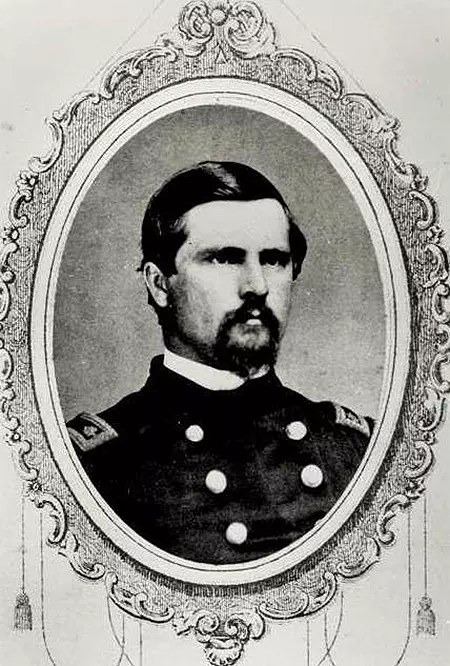 Dr. John Birchard Rice. Middle Bass Club member from 1881 to 1890. Fremont, Ohio. Source: Find A Grave
Dr. John Birchard Rice. Middle Bass Club member from 1881 to 1890. Fremont, Ohio. Source: Find A Grave
Dr. John Birchard Rice
John Birchard Rice was born in 1832 in Lower Sandusky (now Fremont), Ohio. He studied at Oberlin College for two years and then enrolled at University of Michigan Medical School where he graduated in 1857. Dr. Rice continued his medical training at Jefferson Medical College in Philadelphia and at clinics in Bellevue Hospital in New York City. He married Sarah E. Wilson in 1861 and was practicing medicine with his father, Dr. Robert S. Rice in Fremont at the onset of the Civil War. Dr. Rice volunteered to serve and was appointed Assistant Surgeon of the 10th Regiment Ohio Volunteer Infantry (OVI) serving in West Virginia. In 1861 he was promoted to Surgeon and assigned to the 72nd OVI where he stayed until the end of the war.
- “Dr. Rice was handicapped in his surgical work during the war by a complete lack of antiseptic facilities … and he possessed only an equipment of an old time saw and lancet and had no sanitary protection even for himself or his patients.” (History of Northwest Ohio, Vol. III, by Nevin O. Winter, LITT D, 1917, p. 811)
- One surgical achievement by Dr. Rice during the Civil War was an elbow joint resection surgery performed on Private J. L. Jackson of the 72nd OVI, Company A. Private Jackson survived, recovered and later became a night watchman in the Treasury Department in Washington, D.C. (History of Northwest Ohio, Vol. III, by Nevin O. Winter, LITT D, 1917, p. 811)
After the war, Dr. Rice returned home to his wife and medical practice in Fremont, now working with his brother Dr. Robert Harvey Rice. He was a faculty member of the Charity Hospital Medical College of Cleveland and a lecturer on military surgery and obstetrics in the University of Wooster. “Throughout the remainder of his life he occupied a recognized position as one of the foremost surgeons and physicians of that portion of Ohio.” (History of Ohio, The Rise and Progress of an American State by Emilius O. Randall and Daniel J. Ryan, 1915, p. 654)
Besides medicine, he founded the Trommer Extract of Malt Co in 1875 with his brother Dr. Robert H. Rice, Stephen Buckland and Dr. Gustavus A. Gessner. Politically, Dr. Rice served as a U.S. Congressman from Ohio’s 13th district from 1881 until 1883; he decided to return to Fremont after one term.
Dr. John B. Rice was a member of the Middle Bass Club (MBC) from 1881 to 1890 and had many family and business relationships within the Club.
- One brother, Dr. Robert H. Rice joined the MBC in 1881 and remained a member until 1902. Robert H Rice served in the Civil War, Unit B of the 176th Ohio Infantry.
- A second brother, Charles Fitch Rice joined the MBC in 1888.
- A third brother, Alfred H. Rice, was a member of the MBC from 1888 until 1895 and was involved in the mercantile business and a well-respected attorney. Alfred Rice served in the Civil War in the 72nd
- His brother in law, Charles Granville Wilson, an attorney and banker from Fremont was also a MBC member in 1888.
- Gustavus A. Gessner of the Tommer Extract of Malt Co. was also a MBC member from 1881 to 1890. Dr. Gessner was doctor in the Civil War assigned to the 21st Regiment OVI.
Dr. Rice is buried in Oakwood Cemetery in Fremont.
It should be noted that the Rutherford B. Hayes Presidential Library has a collection of Rice family correspondence from the Civil War.
General Wager Swayne. Middle Bass Club member 1877. Sources: Encyclopedia of Alabama (left); Wikipedia (right).
General Wager Swayne
Wager Swayne’s parents moved from Virginia to “free territory” because of their strong opposition to slavery. In fact, his mother freed her inherited slaves in Virginia. Later Wager Swayne was born in Columbus, Ohio in 1834. He graduated from Yale in 1856 and then Cincinnati Law School in 1859 and was a practicing lawyer in Toledo at the onset of the Civil War. It should be mentioned that in 1861, Wager Swayne’s father, Noah Haynes Swayne Sr., was President Lincoln’s first appointee to the United States Supreme Court. Associate Justice Noah Haynes Swayne served until 1881 and was a strong supporter of President Lincoln’s Civil War measures.
The highlights of General Swayne’s military career include:
- Appointed Major in the Union Army, 43rd Ohio Volunteer Infantry (OVI) by Ohio Governor William Dennison on August 31, 1861.
- “Participated in the capture of New Madrid and Island Number Ten and in the campaign down the Mississippi River, for much of the time being in command of the regiment, as its colonel, J.L. Kirby Smith was occupied with the command of the brigade.” (History of Ohio, The Rise and Progress of an American State by Emilius O. Randall and Daniel J. Ryan, 1915, p. 152)
- Awarded the Medal of Honor in August 1893 for “Conspicuous gallantry in restoring order at a critical moment and leading his regiment in a charge” during the second Battle of Corinth in Mississippi when his commanding officer Colonel J. L. Kirby Smith was mortally wounded on October 4, 1862. (Source: Congressional Medal of Honor Society website) General Grenville M. Dodge remarked, “Under a withering fire he changed front without confusion, a movement that would have tried the mettle and steadiness of any regiment that ever saw a battlefield, and, together with the Sixty-third Ohio, he is credited with defeating the determined effort of the enemy to take Forts Williams and Robinette.” (History of Ohio, The Rise and Progress of an American State by Emilius O. Randall and Daniel J. Ryan, 1915, p. 152)
- “Swayne led the 43rd OVI with distinction during the Atlanta Campaign until February 2, 1865 when he suffered a severe wound at the Battle of Rivers’ Bridge in South Carolina which resulted in the amputation of his right leg.” (Source: Wikipedia)
- Appointed Brigadier General of Volunteers on March 13, 1865 by President Abraham Lincoln, confirmed by Congress on March 10, 1865. (Source: Wikipedia)
- Appointed Major General of Volunteers on May 1, 1866 by President Andrew Jackson, confirmed by Congress on April 26, 1866. He was the last Major General of Volunteers appointed during the American Civil War. (Source: Wikipedia)
- Commissioned Colonel of the newly authorized 45thS. Infantry which was later consolidated into the 14th U.S. Infantry in 1869.
- Brevetted Brigadier and Major General, United States Army in 1867. General Swayne left the Volunteer Army but remained in the United States Army.
- Served as Assistant Commissioner of the Alabama Freedmen’s Bureau until 1868 where he “instituted various enterprises for the education of the blacks to provide them with sustenance and the opportunity to become self supporting.” (History of Ohio, The Rise and Progress of an American State by Emilius O. Randall and Daniel J. Ryan, 1915, p. 154) General Swayne is credited with securing funds to establish temporary schools and permanent educational institutions at Talladega, Montgomery and Mobile constituting “the first educational privilege of the colored people of that state had ever enjoyed.” (Source: History of Ohio, The Rise and Progress of an American State by Emilius O. Randall and Daniel J. Ryan, 1915, p. 154)
After Alabama, General Swayne was assigned to duty in the war department at Washington. In 1868 General Swayne married Ellen Harris from Louisville, Kentucky. Upon his retirement in 1870, General Swayne returned to Toledo to practice law and remained there until 1879. He then moved to New York City to serve as counsel for several significant railroad and telegraph companies.
General Swayne was a founding member of the Middle Bass Club (MBC) in 1877 and had numerous family relationships within the Club membership.
- One brother, Francis Bond Swayne was a founding member of the MBC who retained his membership until 1898. He moved to New York City where he was a noteworthy railroad attorney. Francis B. Swayne’s wife, Helen Young, was the sister of 2 MBC members: Horatio Sam Young and Morrison Waite Young.
- Horatio Sam Young was a founding MBC member who kept his membership until his death in 1894; his wife Antoinette King remained a member until 1904 His father in law, Francis J. King, was a member from 1881 until 1890; his wife continued to be a member until 1904. It should be noted that Horatio S. Young served in the Civil War, 130th OVI, Company C.
- Morrison Waite Young was a MBC member in 1904. He married Kittie Cummings whose father John Cummings was a member from 1881 until 1907, Uncle Joseph W. Cummings was a founding club member active until 1898 and Uncle William Cummings was a MBC member from 1888 until 1898. John Cummings was a Toledo broker and businessman. Joseph W. Cumings was an attorney and judge who “enlisted in an Indiana company in the Civil War, but the company was not used due to a lack of weapons. He later enlisted for 30 days to help in the defense of Washington when it was attacked by General Early and General Breckenridge.” (Source: Find A Grave). William Cummings served as the Treasurer of Lucas County and was involved in the Produce Exchange and the Northern National Bank. Morrison Young’s sister in law, Elizabeth Sinclair Cummings, married Silas Cornell Walbridge who was a MBC member from 1904 until 1907. Silas Cornell Walbridge’s brother Carlton Hopkins Walbridge was a MBC member in 1890, brother Ebenezer Franklin Walbridge was a member in 1904 and Uncle Herman D. Walbridge was a founding member of the MBC active until 1881.
- A second brother, Henry Stewart Swayne, was a founding MBC member in 1877.
- A third brother, Noah Haines Swayne Jr., was a founding member retaining his membership until 1904. Noah H. Swayne Jr.’s law practice included Rathbun Fuller whose father General John Wallace Fuller was a MBC member from its inception in 1877 until 1890. Noah H. Swayne Jr. provided the “vision and land for the Swayne baseball field in Toledo, home of the Toledo Mud Hens from 1909 until 1955.” (Source: Find A Grave)
Thus, the Swayne, Young, King, Cummings and Walbridge Middle Bass Club families were all related by marriage.
General Swayne is buried in Section 3 of Arlington National Cemetery beside his wife Ellen Harris Swayne.
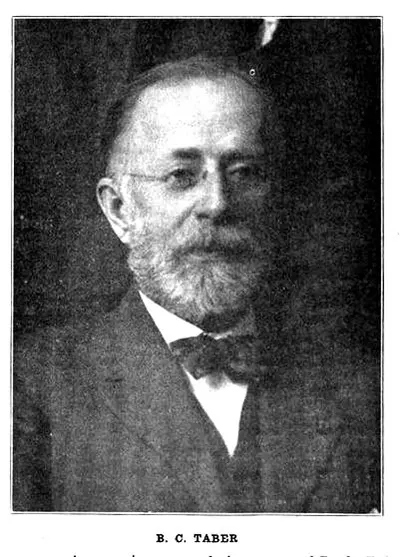 Benjamin Charles Taber. Middle Bass Club member from 1890 to 1898. Norwalk, Ohio. Source: Find A Grave
Benjamin Charles Taber. Middle Bass Club member from 1890 to 1898. Norwalk, Ohio. Source: Find A Grave
Captain Benjamin Charles Taber
Benjamin Charles Taber was born in 1840 in Somerville, New Jersey and moved to Norwalk, Ohio in 1856 working as a store clerk. After gaining experience and possessing good business and organization skills, he took over the successful dry goods store Parker, Manahan & Taber Co. and renamed it the B. C. Taber Company. He was one of the original incorporators of the Huron Country Banking Company serving as Vice President and then President. “Mr. Taber’s fame as a great merchant and financier was not confined to his hometown, but he was widely known and respected in the business and banking circles of New York, Cleveland and other cities where he had investments and connections.” (The Firelands Pioneer, Vol. 21, 1920, p. 2480)
When the Civil War started, he was the first to be placed on the original muster roll of volunteers for the Norwalk 55th Ohio Volunteer Infantry (OVI), Company D. Captain Taber served the Union Army every day of the Civil War (September 13, 1861 until December 28, 1864) and fought in 20 major battles including: (Source: Find A Grave)
- Bull Run – Manassas, VA – August 1862
- Chancellorsville, VA – May 1863
- Gettysburg, PA – July 1863
- Siege of Atlanta, GA – December 1864
After serving in the war, Captain Taber married Mary Parker in 1866 and together they had 3 children: Cora Isabelle, Thomas and William. Captain Taber was a member of the Middle Bass Club (MBC) from 1890 to 1898 and had the following family connections:
- His father in law and business partner, Constantine Sobieski Parker, was a member of the MBC in 1888.
- His wife’s uncle, Welcome Otis Parker was a founding member of the MBC in 1877 who remained a member until 1898.
Captain Taber is buried in Woodlawn Cemetery in Norwalk, Ohio.

